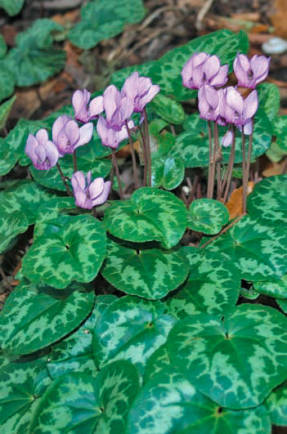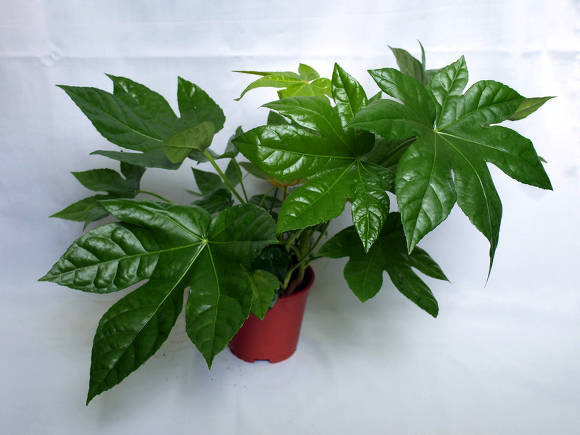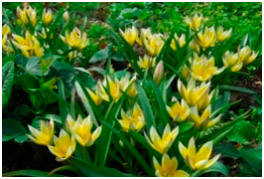Cyrtantus sublime (Cyrtanthus elatus), better known under the old name Vallota the beautiful(Vallota speciosa) is a very beautiful plant. Despite its overseas origin, it takes root well in indoor conditions and blooms luxuriantly if you create favorable conditions for its existence in the room. Another indisputable advantage of this indoor miracle is that once having acquired a single bulb, over time you can become the owner of a whole mini-garden of indoor lilies.
More details - on the page Cyrtantus.
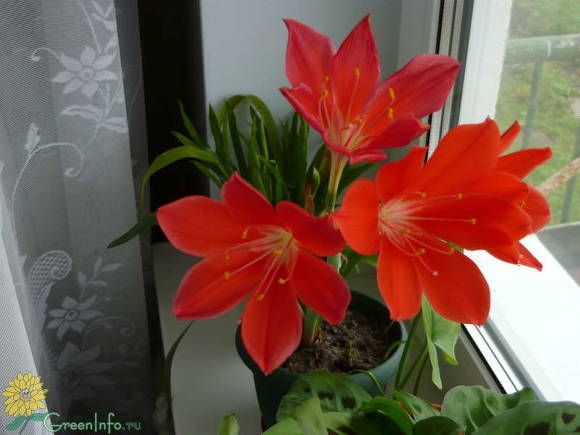
This plant comes from the subtropical zone of South Africa, more precisely, the Cape region of South Africa. In indoor floriculture, cirantus has appeared since the 17th century. Vallota has won the love of flower growers around the world thanks to its spectacular red flowers, very similar to large bells with graceful golden stamens. This flower received its first botanical name from the surname of the French biologist Pierre Vallot, who gave the first scientific description of this plant.
In its natural habitat, this plant blooms best in the place of old fires in the tropical jungle. It is believed that it was this "whim" of his that gave him his popular name - "fire lily".
Among the characteristic features that distinguish this plant from other members of the amaryllis family, the most striking is the color of the base of the leaves with a deep purple color. The leaves of the vallota are long, belt-like, flat, fan-shaped, their shape and color differ depending on the species. Some have very narrow and smooth leaves, while others are wide and twisted into a spiral. The color of the leaf plate can be in a green palette of various saturations - from bright green to matte and dark green. The length of the leaf blades can reach 40-50 cm; as it grows, the lower row of leaves dies off, forming a scaly trunk at the base of the bulb.
The bulbs of this plant are elongated, round-pear-shaped, with a short neck, monopodial, filmy. This shape of the bulb distinguishes the vallotha from its close relatives: hippeastrum, amaryllis and clivia. The color of dried scales is another distinctive feature of the genus: their upper side is brown, and the inner side is light crimson.
The third characteristic feature of the vallotta is the presence of numerous children, which, forming inside the bulb, do not break through the tissues, like in many other bulbous, but with the help of special "legs" they themselves "get out" upward, breaking away from the mother plant, they can be seen even on the surface of the soil ...
The plant develops at an average rate, reaching a height of no more than 0.5 m. One bulb can live up to 20 years.
Flowering in this species usually occurs in mid-summer, but some specimens with a strong bulb can bloom twice - in spring and autumn. Each bulb can give 2-3 thick peduncles up to 60 cm long, bearing an umbrella-shaped inflorescence of several star-shaped, funnel-shaped or tubular 6-petaled flowers, the shape and color of which depends on the type of plant. At the top of the peduncle, up to 8 flowers with a diameter of 6-8 cm of bright red or scarlet color with a white center can form - this is the natural palette of this plant. Today, through the efforts of breeders, varieties of vallottes with white, cream, lilac, pink flowers have been bred. Common to all wallots is the presence of long filamentous stamens with large oval yellow anthers, which give the flower a special charm.
The life span of a peduncle in a vallot is up to a week. After a week of flowering, the plant begins to form seed pods, which are recommended to be removed immediately so that the plant does not waste its energy.
Care features
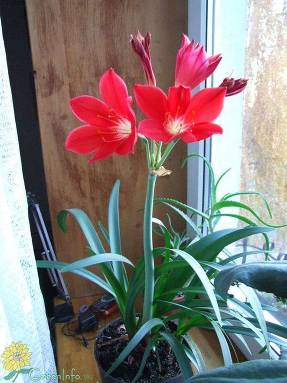
Lighting. The plant is photophilous, bright lighting - direct sunlight in the morning and evening hours - is necessary for rich flowering.Windows of the east or west direction are well suited for its placement. The southern side will require mandatory shading from the midday sun, which will negatively affect the leaves of the vallotta, and the northern side will require additional lighting even in summer daytime hours. During the dormant season, Cyntanthus requires less light.
Read more in the article Lighting for indoor plants.
Temperature. In summer, the plant is comfortable with a temperature in the range of + 23 ... + 26 ° C. Vallota can withstand higher temperatures, but with regular watering.
Dormant period... In winter, during the dormant period, a bright, cool room is suitable for this species, where the air temperature will be about + 10 ° C. Vallota does not like drafts and sudden temperature changes.
Soil and transplant. The soil for this plant is selected nutritious, moisture and breathable. The composition of the soil mixture for self-preparation: leaf, turf, humus, peat and coarse river sand in a ratio of 2: 1: 1: 1: 1. A good drainage layer is arranged at the bottom of the pot.
Cyrtantus does not like large containers. This plant blooms best in a compact container, so a narrow, high container must be chosen for growing a vallotta. In wide pots, the plant will give too many babies, the bulbs will be crushed and bloom poorly. Sometimes, for decorative purposes, several bulbs are planted in a large pot at a distance of 8-10 cm from each other.
The vallot is transplanted as needed, only when the roots become too long. This is usually done in the spring, once every 3-4 years.
The transplant is carried out as follows: the mother bulb is carefully removed from the old pot, carefully separating the children, the delicate roots of the vallota are slightly shaken off the soil, the roots are examined, removing the rotten ones, they are sprinkled with ash. The prepared bulb is placed in a new container, covered with fresh soil so that 2/3 or half of the top of the bulb is above the soil level, the plant is watered and placed in a slightly shaded place before the leaves begin to grow, then the flower is returned to the sunny side.
Vallota bulbs are not immersed too deeply in the container so that later the children can be easily separated.
- Soils and soil mixtures for indoor plants
- Transplanting indoor plants
Watering... Watering is moderate. The top layer of soil in the pot should dry out by 80-90% between waterings in the active phase of the plant's life. In winter, watering is carried out when the substrate is completely dry. Overflowing, as well as stagnation of water in a pot or pan can lead to rotting of the bulb and the death of the plant. The plant tolerates a short-term lack of moisture better, but in the case of a longer dry period, in order to retain moisture, the vallot will begin to shed its leaves.
Read more in the article Watering rules for indoor plants.
Air humidity... Vallota is not very demanding on the humidity in the room, but in the summer, light spraying with warm water, without getting on the flowers, and installing a pallet with wet pebbles will be useful.
Regularly wiping dust off the leaves of the plant with a soft, well-absorbing cloth will also contribute to the well-being of the vallotta.
Top dressing... During the active growing season, feeding is carried out at a frequency of 2 times a month with special complex mineral fertilizers for bulbous plants. In winter, feeding is stopped and resumed again in late February - early March.
Read more in the article Top dressing of indoor plants.
Pruning. Pruning is carried out to free the plant from completely dried leaves. Until the leaf has completely changed color, it is not cut off. After flowering, completely wilted peduncles are also removed.

Breeding vallot
The easiest way to breed a wallot baby onions, which are carefully removed from the mother bulb or simply collected from the surface of the soil in a pot.Young bulbs are planted in separate small cups with potting soil and holes in the bottom and a drainage layer. The bulbs are deepened into the ground by no more than half or 2/3. The flowering of a young plant occurs in 2-3 years.
Some varietal hybrids of cirtantus do not give children well. In this case, reproduction is carried out by the method division: The parent bulb is cut into 2–4 pieces so that each has roots. The incision sites are powdered with ash and dried a little. Then the delenki are planted in personal cups with soil mixture to root. Rooted plants will bloom in 3 years.
Seed reproduction rarely used. It is usually held in October or November. The seeds are pre-soaked in a saturated solution of potassium permanganate and germinated between layers of moistened gauze or filter paper. Then sowing is carried out into the substrate to a depth of about 5 mm. Cover with glass or foil and germinate with bottom heating. Periodically, the shelter is removed to water and feed the seedlings. Shoots appear after 20 days. After 3.5 months, small bulbs are transplanted, completely immersed in the ground. Plants are watered moderately. A year later, in spring, the grown bulbs are transplanted so that the root collar is slightly visible above the soil surface. With seed propagation, the vallot will bloom in 3 years.
Diseases and pests. The poisonous sap of citantus does not repel spider mites. To combat them, you must thoroughly rinse the long leaves of the plant under running warm (about + 40 ° C) water. This procedure may need to be repeated several times.
Diseases are most often caused by a violation of the watering regime. In this case, cytantus can get sick with fungal infections: gray, black or red rot. The mushroom usually settles at the base of the stem, and quickly eats away the leaves. To combat various rot, they are treated with special fungicidal preparations.
Read more in the article Houseplant pests and control measures.
Virulence. It must be borne in mind that this plant is poisonous - the leaves, roots and flowers of the plant contain toxins. Bulbs containing the highest concentration of poisonous juice, the active ingredient in which is the alkaloid lycorin, are especially dangerous. Large doses of the toxin cause vomiting and indigestion.
When the juice of the plant gets on the skin, it turns red, itching appears, therefore, all manipulations with cyrtantus must be performed using rubber gloves. And after working with the plant, you must thoroughly wash your hands and used tools with soap.
For a plant, it is better to choose a place out of the reach of children and pets.
Photo from the GreenInfo.ru forum

